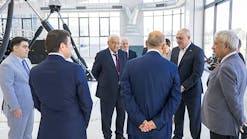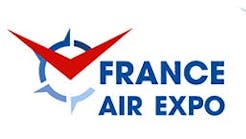How Forging Extends Component Life and Alleviates Supply Chain Bottlenecks in Aerospace
The aerospace manufacturing process is incredibly complex and can be demanding on all parts of a manufacturing supply chain. With the aerospace industry operating at the cutting edge of human engineering, thousands of people rely upon the integrity of airplanes and helicopters every single day.
Yet, in the Q4 2019 Boeing earnings call, Boeing officials paid close attention to the health and maintenance of the supply chain and the integrity of the components therein. David L. Calhoun, CEO of Boeing, stated, “...this industry has been supply-chain limited and constrained.” With thousands of critical components working to ensure consistent, safe operation, manufacturers need the best parts made from the best materials with the best processes to ensure the constant and continued integrity for all of these “can’t fail” parts. While casting may seem like the standard choice for affordable, quick, and complex parts, forging has proven to be the far superior process for forming these types of “can’t fail” parts with the industry increasingly growing its capacity to create these crucial components.
Component Longevity
Research conducted by members of the Mechanical, Industrial, and Manufacturing Engineering Departments at the University of Toledo found that using forged components, such as forged aluminum parts, provides a substantial extension in the lifespan of given parts compared to cast alternatives.
In their study, entitled “Fatigue Performance Comparison and Life Prediction of Forged Steel and Ductile Cast Iron Crankshafts,” the university’s research findings demonstrated that forged parts have a 26% higher tensile strength, meaning the parts can suffer greater pulling stresses. This is ideal for hanging mounts or helicopter slings. The study also found that forged parts have a 37% higher fatigue strength, which results in a greater length of service for the component. Perhaps the most striking finding to those unfamiliar with the benefits of the forging process was that forged parts have a 44% greater yield strength than castings, with forged parts able to undergo significantly greater stresses before succumbing to deformation.
With the continuous operation of components in airplanes and helicopters playing an absolutely vital role in ensuring the consistent operation of such vehicles and the safety of the individuals on board, it’s worth noting forged parts also have a much greater deformation area before failure. This greater deformation area, combined with the greater yield strength of forged components, means forged parts don't deform as quickly as non-forged parts. These characteristics also lengthen the time between deformation and critical part failure. There is a reason that other metalworking processes often draw comparisons to the properties of forged aluminum components — it’s because forged parts provide a greater degree of safety with a considerably prolonged operational lifespan.
Forged aluminum aerospace parts also require less heat treatment to achieve desired strength properties, as the process of forging creates a strong part with an interlocked grain structure. All metals form a crystalline structure when they cool, but with non-forging processes, that crystalline structure can be deformed drastically.
With forged components, the complex structure produced through deformation energy allows aluminum parts to approach the powerful properties of complex alloys like Inconel. This improved metallurgy translates not only to greater performance but longer-lasting pieces with greater fatigue properties. In addition, these properties can be achieved with significantly cheaper base materials. The accessibility of cheaper materials also bypasses the necessity of researching exact alloy compositions and complex testing procedures.
Material & Part Sourcing
The aerospace component bottleneck is a problem that has persistently plagued the industry, but what is it exactly that causes the issue?
The most persistent, identifiable concern is material sourcing. Kevin Michaels, managing director of AeroDynamic Advisory, stated raw materials are an often-overlooked vulnerability of the global aerospace supply chain — a fact which was made all the more readily apparent during the onset of COVID-19. In conjunction with tariffs imposed by the federal government on aluminum sourced from overseas, many aerospace manufacturers have experienced rising costs and continuously delayed projects.
However, many forgoing companies have long been ahead of the issue in their ability to offer 100% domestic material sourcing combined, long-standing relations with material suppliers, and insightful stocking methods that reduce lead times for key raw material items. Among those companies operating in the industry, these particular characteristics enabled many top-quality forgers to remain immune to interference by foreign markets and resistant to supplier disruptions, thereby enabling the rest of the aerospace manufacturing process to continue on-budget and on-schedule.
Logistics & Procedures
Overly complex logistics commonly produce slowdowns at a number of different points in the manufacturing process. It’s not uncommon for companies to run into issues communicating engineering, design, or logistics-based needs to contractors and suppliers based overseas. Differences between timezones, languages, and expected levels of quality often require additional follow-ups for verification in addition to weeks of time spent in shipping and clearing customs.
When domestically based forging companies use domestically sourced materials, aerospace manufacturers are increasingly able to communicate their product requirements, or the need for any changes, directly. Domestically based AS9100 certified forgers are also commonly able to have field engineers on-site, gathering a technical understanding of the manufacturer’s part, the part’s specific use, and, in some cases, even recommending improvements to the final design. The streamlined process of working with domestically based forging companies is allowing for greater flexibility, minimized travel time, and improved communications which have begun to open the aerospace bottleneck.
Beyond logistical issues, many companies have long suffered from inefficient processes and out-of-date procedures. The aerospace industry has long been squeezed under the strain of legacy methods and outdated mindsets when it comes to manufacturing their components. Forging companies have largely solved these issues through powerful manufacturing techniques that maximize the throughput of products and covers for the inherent slowdowns in the forging process. This, combined with a shift in the industry to a cellular workflow and companies that maintain a wide variety and redundancy of presses, has created an efficient forging process and a means to escape from the bottleneck of the supply chain.
Quality Assurance & Inspection
The final part of the forging process is, of course, the most important: quality assurance and inspection. Complex aerospace parts can require a long inspection procedure to ensure part quality and consistency.
Forging companies that use cellular manufacturing processes and special “consistency by process control” methods allow for consistent quality all through a production run. In the actual inspection procedure, forging companies use a combination of old-school physical and stress testing, along with tried-and-true CMM inspection and even state-of-the-art 3D scanning inspection technologies. The powerful combination of quality assurance procedures works to ensure that aerospace customers are receiving the best and most consistent product possible and receiving it on-time.
Trust the Premier Method of Metal Forming
Forging creates a more reliable, uniform and stronger part, and a faster turnaround at a reasonable price. For those parts that are critical and cannot fail, forging is the premier method of metal forming.





